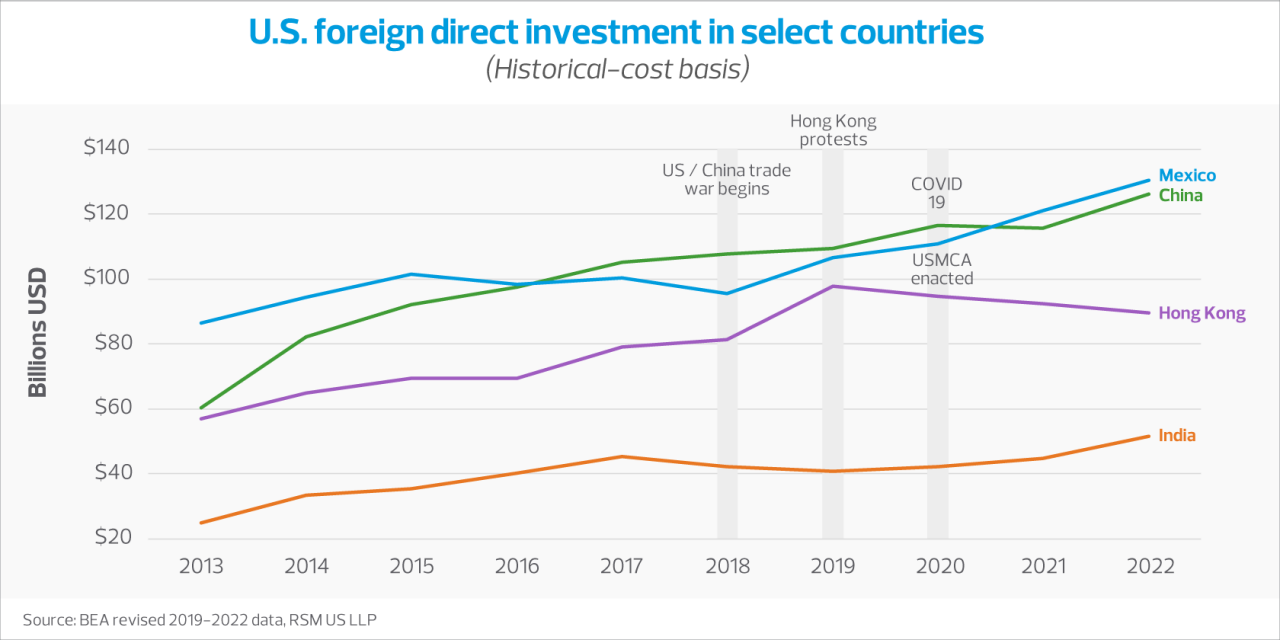U.S. foreign direct investment in China has not ceased, but the landscape is shifting.
Businesses must examine whether diversifying their locations will maximize long-run prospects.
Assessing the feasibility of a potential change—and the business case for it—will be key.
The picture of globalization is shifting, and manufacturers are diversifying risk away from China by reassessing alternative supply chain structures, even with the understanding that such changes may bring higher cost. This shift is unlikely to translate to a widespread reshoring of manufacturing operations back to the United States, but it does have many companies considering whether to continue their operations in China or direct some—or all—of those operations elsewhere.
Geopolitical tensions and rapidly shifting government policies in China—including a new data security law—have given many companies and investors cold feet about making additional investments there. Some U.S. companies that want to remain in China have taken extreme measures to separate their Chinese businesses from their U.S. operations. Such measures include relocating some intellectual property and data to China, where the U.S. business can no longer access it, to keep their foothold in the market.
Many businesses will need to maintain a presence in China because of its continued role as a trade powerhouse, but many will also likely hedge and diversify operations to other countries in Asia or somewhere in the Americas.
However, manufacturers weighing whether to reduce their footprint in China should not make that decision in haste. Given the shifts in globalization, businesses need to thoroughly examine whether diversifying their locations will maximize their long-run prospects. The forces that led an organization to start operations in China may not be the same as the forces now leading it to look elsewhere or rethink its business models. Many companies entered China seeking lower labor costs, whereas now the focus has shifted to reducing risk and disruptions to supply.

The forces that led an organization to start operations in China may not be the same as the forces now leading it to look elsewhere or rethink its business models.
Foreign direct investment: Signs of a shift
To be sure, U.S. foreign direct investment (FDI) in China has not ceased, but the landscape is shifting, with U.S. FDI into Mexico now ahead of China. U.S. FDI into China increased 17% from 2018—when the trade war began—to 2022, while FDI into Mexico grew 36% during that time, according to the U.S. Bureau of Economic Analysis.
In 2022, the U.S. invested $130 billion in Mexico compared to $126 billion in China. Also important to consider is U.S. FDI in Hong Kong, which soured after protests there against a 2019 bill that would have allowed extradition of Hong Kong residents to mainland China, and declined further after China passed a 2020 national security law that chilled Hong Kong’s pro-democracy movement and its business-friendly reputation. U.S. FDI in Hong Kong declined 9% from 2019 to 2022.
Along with proximity to the United States, the United States-Mexico-Canada Agreement, which went into effect in 2020, is clearly benefiting Mexico. This shift signals a pivot of investment back to North America.
But countries beyond North America are experiencing a shift too. U.S. FDI in India increased 22% from 2018 to 2022. India has the world’s second-largest workforce behind China and more favorable long-term demographics than that country, whose working-age population is shrinking as India’s continues to grow.

We expect to see a sharper increase in U.S. FDI into Mexico and India in 2023 and lower investment into China and Hong Kong.
Looking for ways to build supply chain resiliency?
Assessing a potential change
Before a business makes significant changes in the location of its operations, productions or suppliers, leadership should consider some high-level questions, including these top three:
- Can you clearly define the company’s reason to consider shifting manufacturing and sourcing? Numerous factors are likely at play if your business is considering moving away from China—customer proximity, risk reduction and improved supply chain resilience are just a few. Diversifying to new locations might improve predictability and reduce disruptions, but whatever the factors, management must have a clear hypothesis, and validate it, before making a decision. This process can include an industry-specific risk analysis that evaluates the likelihood of significant disruptions and outlines a plausible way to address that risk.
- How feasible is the proposed change? Having operations in China can still yield plenty of benefits, including lower-cost skilled labor, access to raw and refined materials, and a huge local market. Companies need to thoroughly assess what a shift away would mean for specific products. Would you still get the raw materials you need in a potential new market? Would you have access to people with the necessary skill sets? Would senior management be able to manage the shift? Manufacturers also need to determine whether the proposed change would involve a straightforward “lift and shift” of operations, or present a strategic opportunity to invest in new equipment.
- What is the business case for the change, and is it worth it? A rational business case can help manufacturers determine whether they will be able to profit in the new location when considering input costs such as labor, materials, overhead, and transportation (inbound and outbound). In addition, companies need to evaluate their ability to produce goods of the same quality in the new market, conduct a supplier study to gauge access to the raw materials they need, and determine whether they can improve their service to customers.
Teams that answer these questions thoroughly still need to contend with the fact that China’s market is not going anywhere, and the country is still one of the best long-term markets to invest in—on paper, at least. But as growing risk and uncertainties year over year continue to give investors cold feet, diversification and risk reduction are becoming increasingly important for manufacturers. Answering the questions above can help align leadership on the best options.

